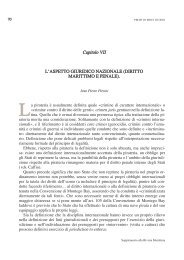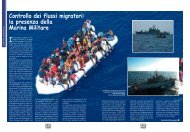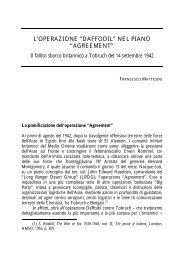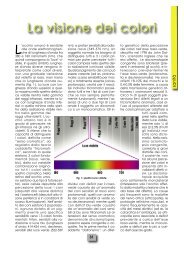143 Anno XVIII - 2008 - Marina Militare
143 Anno XVIII - 2008 - Marina Militare
143 Anno XVIII - 2008 - Marina Militare
You also want an ePaper? Increase the reach of your titles
YUMPU automatically turns print PDFs into web optimized ePapers that Google loves.
or how far and to what extent they will allow<br />
Japan to project military power ashore.<br />
Is Japan building-up its military apparatus and<br />
heading towards a path of maritime power<br />
projection? Is a new sun rising on the horizon?<br />
This paper re-assesses the nature and the purpose<br />
of Japan’s national naval strategy. It argues that<br />
the current pre-eminent focus on procurement<br />
programmes to exercise and maintain sea control,<br />
including Ballistic Missile Defence (BMD),<br />
Aegis and helicopter-carrying destroyers or<br />
tank landing ships, led analysts to overemphasise<br />
Japan’s ‘dangerous behaviour’ as a medium<br />
power. By examining the different criteria and<br />
required military capabilities connected to key<br />
notions like maritime power projection and<br />
expeditionary warfare, the paper postulates that<br />
Japan’s contemporary naval power is not radically<br />
changing in its nature. It maintains that in<br />
light of Japan’s growing international commitments<br />
and concrete regional concerns, the current<br />
evolution of the archipelago’s naval force<br />
is primarily aiming at the procurement of basic<br />
expeditionary capabilities whilst retaining an<br />
effective force against regional forms of power<br />
projection. The structural transformation of the<br />
JMSDF is not part of a menacing plan; rather,<br />
it embodies the service’s attempt to balance a<br />
fleet that some experts considered until recently<br />
well-suited for anti-submarine warfare (ASW)<br />
but incapable of international undertakings because<br />
of the lack of assets in the areas of air<br />
defence, strategic lift and amphibious warfare. 7<br />
A new sun is rising on the horizon, but is one<br />
seeking to maintain an adequate military structure<br />
to protect critical maritime interests and to<br />
contribute to international stability rather than<br />
undermining it.<br />
dIfferencIng MarItIMe<br />
Power ProjectIon<br />
froM exPedItIonary<br />
warfare<br />
Maritime power projection is one of<br />
the crucial ways in which navies can<br />
exploit the command of the sea, employing<br />
‘sea-borne military forces directly<br />
to influence events on land’. 8 For<br />
Sir Julian Corbett, the ability to project<br />
military power ashore was indeed one<br />
of the distinctive attributes of naval forces;<br />
it played to their strengths in that<br />
by freely accessing the sea, a nation<br />
was empowered of the strategic flexibility<br />
to decide when, where and in what<br />
measure it wished to commit its armed<br />
force to military action. 9 Sir Basil<br />
Liddell Hart emphasised that for the<br />
British Empire ‘sea-borne expeditions against<br />
the enemy’s vulnerable extremities’ represented<br />
a key ingredient to its success. The navy was<br />
used to ‘safeguard ourselves where we are the<br />
weakest’, whilst exerting ‘our strength where<br />
the enemy was the weakest’. 10 Emphasis on the<br />
core idea of navies as versatile tools capable of<br />
widening a government’s options in responding<br />
to a crisis or a conflict can be found in today’s<br />
operational lexicons, highlighting that power<br />
projection enables the navy to ‘deliver flexible,<br />
scalable, and sustainable offensive capabilities<br />
at a time and place of our choosing’. 11<br />
Maritime power projection serves offensive<br />
strategies implying the political will to employ<br />
the versatility of naval power to secure a set of<br />
primary military objectives against conventional<br />
forces. It encompasses a wide spectrum of<br />
military actions, ranging from invasion,<br />
territorial conquest, naval bombardment or raids,<br />
and their application depends on the extent to<br />
which these actions are vital to the achievement<br />
of victory at the tactical, operational or strategic<br />
levels of a conflict. For instance, between 1942<br />
and 1945, the nature of the theatre of operations<br />
in East Asia made the maritime campaigns in<br />
the Central and Southwest Pacific conducted by<br />
the United States and its allies essential to the<br />
strategy of defeat of Japan, and represent to date<br />
‘a model for conducting joint operations in a<br />
large theatre against a powerful and determined<br />
enemy’. 12 Similarly, in the 1982 Falklands<br />
campaign, victory was primarily assured by the<br />
Royal Navy’s capacity to acquire sufficient sea<br />
and air control to subsequently land and sustain<br />
ground forces. 13 In cases like the Gallipoli<br />
campaign of 1915 led by a joint British Empire<br />
and French forces, or the Allied landings<br />
in the Mediterranean theatre (1942-1944)<br />
<br />
LCAC durAnte operAzione di sbArCo<br />
33
















